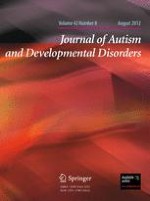01-08-2012 | Original Paper
Self-Monitoring of Gaze in High Functioning Autism
Gepubliceerd in: Journal of Autism and Developmental Disorders | Uitgave 8/2012
Log in om toegang te krijgenAbstract
Atypical visual behaviour has been recently proposed to account for much of social misunderstanding in autism. Using an eye-tracking system and a gaze-contingent lens display, the present study explores self-monitoring of eye motion in two conditions: free visual exploration and guided exploration via blurring the visual field except for the focal area of vision. During these conditions, thirteen students with High Functioning Autism Spectrum Disorders (HFASD) and fourteen typical individuals were presented naturalistic and interactive social stimuli using virtual reality. Fixation data showed a weaker modulation of eye movements according to the conditions in the HFASD group, thus suggesting impairments in self-monitoring of gaze. Moreover, the gaze-contingent lens induced a visual behaviour whereby social understanding scores were correlated with the time spent gazing at faces. The device could be useful for treating gaze monitoring deficiencies in HFASD.
